Automated underwriting software is no longer just a checkbox on your digital transformation roadmap. In 2025, it has become the quiet powerhouse behind the banks and NBFCs that are not just keeping pace with change but confidently setting the pace.
If you are in credit, risk, or product, you already know the pressure. The volume is rising. The regulations are shifting. Customers expect answers in seconds. And somewhere between policy documents, core systems, and exception queues, the logic behind your lending decisions is getting harder to manage and even harder to explain.
But here is the good news. The solutions are not out of reach. In fact, they are already here, and they are being led by institutions that have realized something important. The real transformation does not come from automating forms or digitizing approvals. It comes from rethinking how decisions are made in the first place.
That is where automated underwriting software comes in – powered by a comprehensive digital lending ecosystem – not as another technical layer, but as a decisioning foundation. A way to bring speed and transparency without sacrificing control. A system that helps your teams test, tweak, launch, and govern credit policies in real time, without writing a single line of code or waiting weeks for IT.
And no, this does not mean replacing your people. Quite the opposite. It means giving your credit and risk leaders the tools to move faster, act smarter, and adapt policy without friction. It means building a future where approvals are not just fast, but explainable. Where innovation is not a risk, but a default setting.
This page is not a beginner’s tutorial. It is a deep dive into what is working, what is changing, and how the smartest institutions are using automated underwriting software to take back control of their decisioning.
If you are ready to make credit intelligence a competitive advantage, this is your playbook. Let us get into it.
The Credit Conundrum in 2025:
More Data, More Risk, Slower Decisions
The credit ecosystem has never had more data at its disposal — income streams, behavioural scores, transaction patterns, geolocation trails, psychometrics, alternate bureau signals, and more. Yet paradoxically, underwriting decisions are becoming slower, not faster. And risk, instead of becoming more manageable, is only growing more complex.
Across the board, lending institutions are grappling with a widening gap between data abundance and decision readiness — a gap that automated underwriting software is now being designed to close. It is not that banks lack models, dashboards, or analytics. What they lack is the infrastructure to act — to translate insight into consistent, real-time outcomes without friction.
In most cases, the bottlenecks are not technological. They are architectural and operational.
- Decision logic is buried in code, making every policy tweak a developer-led project—a challenge that modern origination systems that centralize lending work-flows are designed to solve.
- Rules exist across too many teams, often managed in spreadsheets, emails, or proprietary modules
- Legacy systems cannot scale across newer products or customer segments without major overhauls
- Compliance processes slow everything down, because even small exceptions need manual intervention
At the same time, risk dynamics are evolving faster than internal systems can respond. Inflation cycles, geopolitical volatility, informal credit behaviour, and sudden income pattern shifts all demand faster recalibration of credit strategies. But outdated infrastructure simply cannot keep up.
Meanwhile, regulators are demanding higher explainability and auditable trails behind every decision. Customers are demanding instant clarity and fairness. Internal business teams are under pressure to deliver agile lending products in days, not months. And leadership is increasingly asking for visibility, control, and alignment across all decision points.
This is where the true conundrum lies. More tools do not equal more clarity. In fact, they often make it worse — unless they are brought together under a single, governed decisioning engine.
The challenge today is not a lack of credit know-how. It is the inability to apply that know-how consistently — at speed, at scale, and with confidence.
The institutions that solve this challenge are not just making better decisions. They are redefining what it means to lend intelligently in 2025.
Why Automation Is Not the Answer — But Logic Is
In recent years, the term automation has dominated every technology conversation in banking. From onboarding to servicing, from compliance to collections — automation has been the banner under which digital transformation marches forward.
But when it comes to underwriting, pure automation has hit a ceiling.
Yes, banks have digitised workflows. Yes, application processing times have improved. But beneath the surface, many are discovering a deeper problem: they have automated decisions they do not fully understand, control, or even trust.
The result? Credit models that are hard to modify. Approval matrices that require developer intervention. Exceptions that multiply with every product variation. And systems that cannot explain why one borrower is approved while another is not.
Speed without clarity is not progress. It is risk.
What modern lenders need now is not just automation for the sake of speed, but logic that is visible, editable, testable, and aligned with business goals.
This is where the paradigm begins to shift — from chasing automation to building with automated underwriting software that puts logic at the centre.
- Logic first, automation second.Build transparent rule frameworks, then automate what works.
- Ownership shifts to business teams.Credit and risk functions need tools to model, simulate, and adjust decision logic without coding.
- Audits become easier. When rules are visible and centralised, regulators and internal teams can trace the exact path behind every approval or denial.
- Exceptions become intentional.No more manual overrides or undocumented workflows. Variants are designed and governed, not patched in retrospect.
Automated underwriting, at its best, is not about removing people. It is about equipping them with smarter tools so that every decision is made with speed, backed by logic, and traceable from start to finish.
The institutions that are scaling successfully are those that have recognized this distinction. Automation is an outcome. Governed logic is the enabler.
Streamlining workflows is just step one. To truly scale with speed and control, your LOS must serve as the system-of-record and system-of-action—seamlessly connecting upstream channels and downstream systems. Understanding where it fits in the lending tech stack is key to building a future-proof lending engine.
Automated Underwriting Software:
What It Really Means Now
The definition of automated underwriting software is undergoing a quiet, but significant, transformation. What began as a tool for operational efficiency has evolved into a strategic platform that shapes everything from risk posture to product velocity.
In 2025, this evolution is no longer theoretical. It is showing up in real numbers and investment behaviour:
- According to McKinsey, lenders using automated decision engines reduce credit processing time by up to 80 percent and operational costs by 30 to 40 percent. This trend is supported by market data: the global underwriting software market is projected to reach $15.9 billion by 2032, growing at a 12.5% CAGR driven by AI adoption and digital transformation.
- A recent Celent report shows that explainability, real time adaptability, and cross-team configurability have overtaken speed as top procurement drivers for underwriting tech
- 7 out of 10 financial institutions are actively investing in externalised decisioning engines to decouple policy logic from hardcoded systems
What does this shift mean in practice?
It means automated underwriting is no longer about simply replacing human reviewers with faster workflows. It is about building an infrastructure where data, policy, and logic can work in real time — and more importantly, in sync.
Here is what automated underwriting now implies at a strategic level:
- Governance Moves to the Forefront
Institutions can no longer afford to run credit logic on fragmented spreadsheets or hardcoded flows. Modern underwriting platforms act as centralised decision hubs, where business users configure and govern every approval rule, exception condition, and override policy with full traceability.
- Business Becomes the Builder
Instead of routing every change through IT, credit and risk teams now own the decision framework through flexible, modular platforms that adapt to business needs. With no code configuration, simulation environments, and real time publishing, product strategies become living assets, not static documents.
- Speed Comes with Confidence through systems built for explainability and trust:
It is no longer enough to approve fast—you must also know why it was approved, what rule triggered it, and whether it aligns with internal policy and regulatory expectations. Today’s platforms offer rule-level explainability, shadow approval tracking, and simulation logs out of the box.
- Models, Rules, and Human Oversight Coexist
Automated underwriting is not about choosing between manual or machine. It is about integrating AI-suggested rules, pre-built templates, and human judgment into one cohesive loop. Institutions that combine these layers intelligently are outperforming those that rely purely on automation.
Ultimately, the message is clear. Automated underwriting software is no longer a backend tool. It is a decision architecture — one that touches credit growth, risk appetite, customer trust, and product launch cycles in equal measure.
Institutions that understand this are no longer just making faster decisions. They are making better, bolder, and more aligned decisions, everyday.
From Static Code to Smart Decisions:
The Rise of the Rule Engine
For decades, credit policy lived where it least belonged — buried in code, trapped in spreadsheets, or split across systems no one truly owned.
Lending institutions had risk models written in SAS, eligibility logic hardcoded into core platforms, pricing matrices managed in Excel, and exceptions handled over email. This patchwork worked for a while. But as portfolios grew and digital journeys expanded, cracks started to show.
By 2025, the industry has reached a breaking point.
Static logic, hardcoded rules, and disjointed workflows simply cannot meet the complexity and speed of modern credit operations.
To compete today, lenders need to make daily decisions that reflect real time signals — changes in customer behaviour, shifts in regulatory requirements, fluctuations in market risk. But decisions are only as fast as the system that delivers them. If every policy tweak takes weeks of developer time, institutions fall behind — no matter how good their risk models or compliance frameworks are.
That is where the Business Rules Engine (BRE) enters as a foundational shift — not just in technology, but in how credit logic is built, deployed, and evolved.
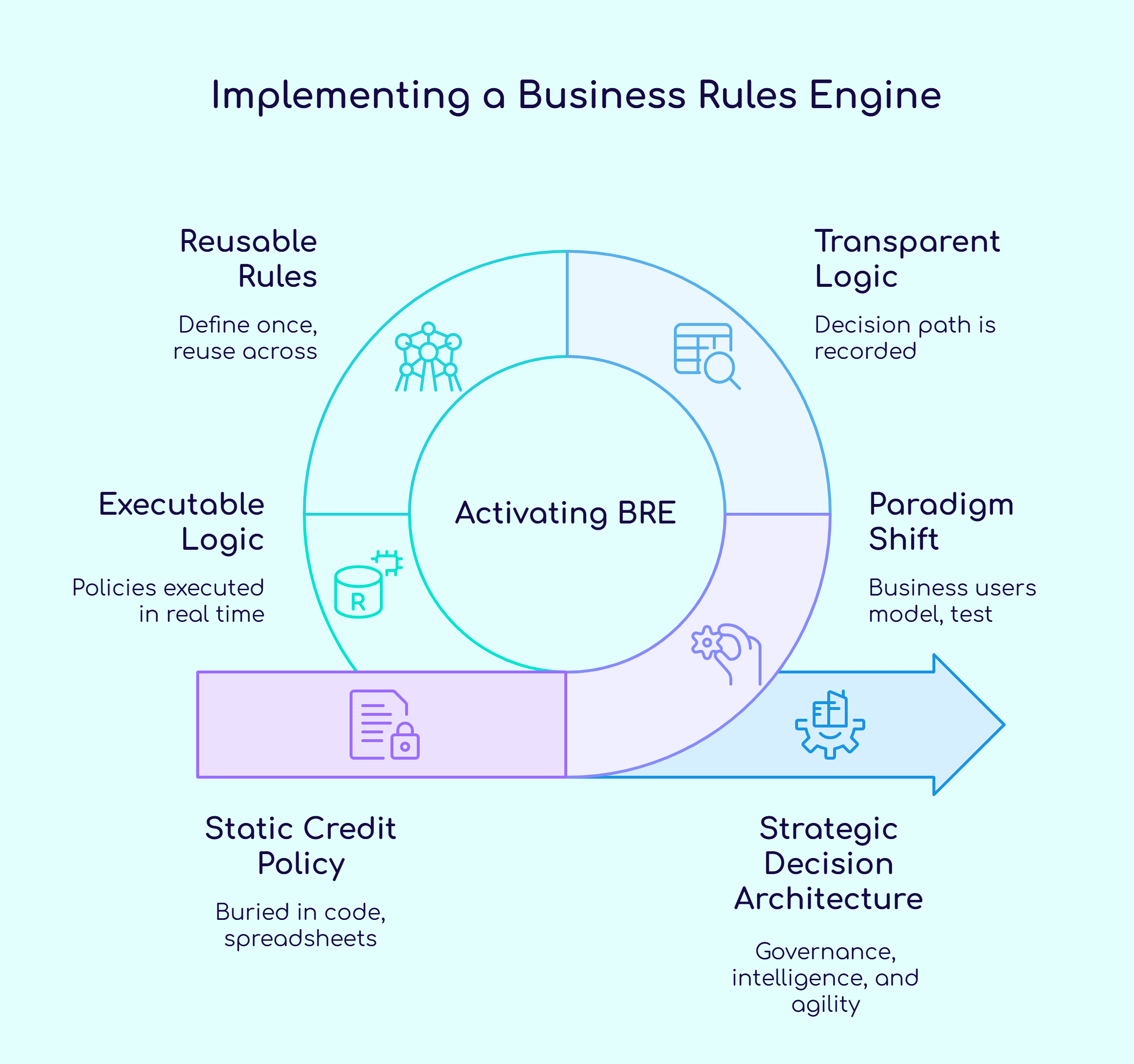
A Paradigm Shift in Ownership
Perhaps the most overlooked benefit of a rule engine is what it does for ownership. Credit and risk teams no longer need to wait on development cycles to change how a product is underwritten. With intuitive interfaces and drag and drop logic builders, business users can model, test, and push policy updates themselves — without writing a single line of code.
This doesn’t just speed things up. It transforms how products are managed. Teams that previously had to document rules and wait on tickets can now experiment, simulate, and launch variants on their own, bringing down time to market dramatically.
Making Logic Transparent and Governed
In legacy systems, a simple question like “why was this loan approved?” often led to hours of backtracking through layers of code, configurations, and version histories.
Modern rule engines flip that. Every decision path is recorded. Every rule is visible. Every override is traceable. The most effective automated underwriting software delivers this level of decision explainability by design — and it is becoming essential.
- Regulators want proof that decisions are fair, consistent, and compliant
- Internal governance teams need visibility into changes and audit trails
- Product heads need to understand how logic aligns with commercial goals
A BRE delivers all of this through centralised, governed decision logic that lives outside the core platform, but orchestrates everything.
Reusable, Context-Aware Rules at Scale
Rule engines also enable modularity and reuse, something rarely possible in traditional systems.
Say you have a customer eligibility rule based on age, income stability, and region. That logic can now be defined once and reused across a dozen products and channels. If you need a variant for a new state or a digital-only journey, it can be layered without rewriting or copying the rule entirely.
Even better, leading platforms now offer AI-assisted rule suggestions based on past outcomes and performance data. This allows teams to combine machine intelligence with human judgment in shaping credit strategy — testing combinations, running shadow approvals, and simulating outcomes before they go live.
From Static Workflows to Strategic Decision Architecture
The most forward-looking banks now treat the rule engine not just as a back-end feature, but as a core part of their competitive infrastructure.
- Credit agility becomes a lever for product innovation
- Policy clarity improves stakeholder alignment
- Explainability reduces regulatory and reputational risk
- Decisioning speed improves customer satisfaction and conversion
In this environment, the idea of policy as code is being replaced by policy as configuration — updated in hours, governed in real time, and owned by the teams who understand lending best.
The rise of the rule engine is not just a technical upgrade. It is a signal that credit decisioning has moved into the spotlight — as a discipline that blends governance, intelligence, and agility in a single framework.
And for lenders looking to lead in 2025, that is no longer optional. It is how the next generation of credit institutions will be built.
Replacing Static Spreadsheets with Executable Logic
Let’s be honest. Spreadsheets have been the unofficial rulebook of underwriting for decades. They are flexible, familiar, and easy to tweak when you are short on time or coordination. Every bank has that one master file — the one with eligibility grids, pricing rules, exception handling logic — passed around like gospel.
But in 2025, that file is becoming a liability.
Spreadsheets were never meant to drive live decisions. They were meant for planning. Reviewing. Maybe prototyping. Not for making real time calls on credit risk or policy thresholds across millions of customers and multiple journeys.
Here is the problem. Spreadsheets are static. They live on desktops or shared drives. They do not talk to your LOS, your CRM, or your rule engine. And they certainly do not log who changed what, when, or why. Every manual edit is a risk. Every version is a potential conflict. And every reliance on these files slows down the very decisioning you are trying to speed up.
In fact, research from Chartis and IDC shows that over 60 percent of banks still rely on spreadsheets for core credit decision logic — and cite this as a top barrier to consistency, explainability, and product agility.
That is why modern lenders are making the shift to executable logic — turning those reference sheets into live, governed, and connected decision rules.
So, what changes when you do that?
- First, your policies are no longer just stored. They are executed in real time, exactly as configured.
- Second, every rule change is versioned and traceable. No more “who edited this formula” confusion.
- Third, logic becomes part of the actual customer journey. No silos. No delays.
- And finally, control shifts from workarounds to workflows. Teams can define approvals, roles, and audits before anything goes live.
This is not just an upgrade. It is a mindset shift.
Instead of chasing sheets and second-guessing rules, your team starts working inside one system of truth—enabled by unified process platforms eliminating spreadsheet dependency, one that scales with your portfolio, adapts with your policy, and earns trust with every decision made.
Spreadsheets were good. Executable logic is smarter. And the difference is showing up in how the best lenders run credit today.
Pre-Built Models, AI Rule Suggestions & Human Control
The most powerful advancement in modern automated underwriting isn’t just automation—it’s the intelligent fusion of pre-built expertise, AI-driven suggestions, and human judgment working in harmony.
Pre-Built Models: Start Smart, Not From Scratch
Leading rule engines—integrated with pre-integrated lending platforms with built-in intelligence—now come with industry-specific templates and pre-configured rule sets that dramatically accelerate implementation. Instead of building credit logic from zero, risk teams can start with proven models that reflect:
- Product-specific eligibility frameworks (personal loans, auto loans, credit cards)
- Industry benchmarks for income verification and affordability checks
- Regulatory-compliant documentation and KYC rule sets
- Common exception handling pathways for edge cases
This allows institutions to customize rather than create—reducing time-to-market from months to days while maintaining full control over the final configuration.
AI Rule Suggestions: Augmented Intelligence in Action
The next frontier in automated underwriting combines human expertise with machine intelligence. Today’s advanced platforms offer:
- Pattern detection across historical approvals and denials
- AI-suggested rule refinements based on portfolio performance
- Predictive rule execution that improves accuracy over time
- Machine learning that fine-tunes rules based on outcomes and feedback
This doesn’t replace human judgment — it enhances it. Automated underwriting software allows credit teams to review suggestions, test combinations, and implement only what aligns with institutional risk appetite and strategy.
Human Control: The Critical Balance
Even as automation advances, the most sophisticated lenders recognize that human oversight remains essential. Modern rule engines provide:
- Clear visibility into every decision path
- Ability to override automated decisions when necessary
- Simulation environments to test rule changes before deployment
- Granular version control to track who changed what and when
This governance layer ensures that while machines may suggest and execute, humans remain firmly in control of credit strategy and policy direction.
The New Workflow: Collaborative Intelligence
The most effective lending institutions have moved beyond the false choice between human or machine intelligence. Instead, they’ve created a new paradigm:
- Credit experts define strategy and risk appetite
- Pre-built models provide the foundational rule structure
- AI continuously suggests refinements based on outcomes
- Human teams review, test, and govern the evolving system
This collaborative approach delivers what neither humans nor machines could achieve alone: decisions that are simultaneously fast, consistent, innovative, and trustworthy.
In 2025, the winning formula isn’t about replacing judgment with automation. It’s about creating an intelligent partnership where technology amplifies human expertise rather than attempting to replace it.
Invisible Yet Essential: The Architecture of a Rule-First Bank
You will not see it on your homepage. It is not something your customers will ever touch directly. But behind every intelligent, agile, and compliant credit product in 2025, there is a decisioning architecture that holds it all together.
And the most strategic lenders are rethinking that architecture from the inside out.
Historically, underwriting logic was embedded deep within core banking systems, hardwired into application workflows, or scattered across teams in multiple tools. Each change — whether regulatory or strategic — required multiple layers of coordination, testing, and dependency on IT.
This setup worked for a static world. But today’s lending demands fluidity, transparency, and scale — and that starts with a dedicated, rule-first architecture.
What a Rule-First Architecture Actually Looks Like
Instead of hiding business rules inside LOS configurations or custom code, institutions are externalising them into a standalone layer — often called a Business Rules Engine. This decisioning layer sits between your front-end applications and back-end systems, orchestrating policy logic in real time.
- Customer applies for a loan
- Data is pulled from bureaus, banking history, alternate sources
- Decision logic runs instantly — eligibility rules, pricing grids, policy exceptions, risk flags
- Response is returned with full traceability of why it was approved or declined
All of this happens without changing the underlying infrastructure. The rule engine connects through APIs, integrates seamlessly with core platforms, and executes at high volume with enterprise-level reliability.
Why the Architecture Matters
Lenders who adopt a rule-first architecture unlock three distinct advantages:
- Adaptability : When the market shifts, rules can be updated in minutes — not months. Policy changes do not require platform overhauls.
- Governance : Every rule has an owner, version, and audit trail. Approvals can be routed through workflows. Risk and compliance teams gain real visibility into how decisions are being made.
- Scalability : As you launch new products, expand to new geographies, or introduce partner-driven journeys, your logic layer stays intact. You simply configure new rules or variants without touching code.
Built for Growth, Not Just Control
A rule-first approach is not just about stability. It is also about speed and creativity. Want to launch a credit card for first-time borrowers with alternate income proof? Build the rule. Want to test a lower risk threshold in a new region? Simulate the outcome. Need to auto-approve low-ticket loans with zero exceptions? Configure it, monitor it, and adjust it as needed — all without writing code.
This is what separates institutions that respond to change from those that lead it.
What Makes It Invisible, Yet Essential
You may not see the rule engine on your screen. But its impact is felt everywhere — in how fast you launch, how confidently you comply, and how consistently you approve.
It is the brain of your decision system, operating in real time, always aligned with business policy, and ready for what comes next.
For banks and lenders looking to stay competitive, this architecture is no longer a future vision. It is a present need.
Compliance Gets Real Time:
What This Means for Policy Automation
In today’s lending ecosystem, compliance is no longer a back-end checkpoint. It is now a live, embedded discipline — one that must operate at the same speed as your credit engine.
Real time approvals are expected. So are real time audits. This is no longer a technology challenge. It is an architectural one.
The Compliance-Credit Divide Is Closing
A few years ago, compliance teams were working weeks behind the credit lifecycle — tracing decisions, reviewing documentation, and running manual audits on spreadsheets and logs. But with faster disbursal cycles, digital-first borrowers, and tightening regulatory scrutiny, that model is unsustainable.
Institutions now need a setup—including digital identity verification integrated with decisioning—where credit decisions and compliance validations happen within the same engine.
And that is exactly what modern rule-based underwriting enables.
Use Case 1: Real Time Audit Trails for Regulatory Response
A mid-sized bank in Southeast Asia was flagged for inconsistent approvals in SME lending. Investigations revealed that different branches were applying slightly different logic to the same eligibility matrix — manually adjusted in spreadsheets.
After moving to a governed decisioning layer, every rule version, override, and exception was logged in real time. Within weeks, the bank was able to respond to audits with clear decision trails, including who made a change, why it was applied, and what result it triggered — all without manual retrieval.
Use Case 2: Automated Approval With Embedded Policy Controls
One North American lender used to rely on post-facto checks for risk-tiered loans, reviewing a subset of cases every quarter. With real time policy enforcement, approval logic now runs through pre-cleared, compliant rule sets — covering risk thresholds, document validations, and exception handling before a decision is made.
This reduced quarterly compliance escalations by 42 percent, and eliminated the need for separate exception reporting in 80 percent of approved cases.
Use Case 3: Collaborative Governance Without Bottlenecks
Another institution, launching new credit variants across three geographies, embedded region-specific rule approvals into the publishing workflow. Risk and compliance teams reviewed and signed off directly inside the engine — with simulation logs, audit previews, and version history all available in one place.
This meant product velocity did not suffer while regulatory guardrails remained intact.
Real-Time Compliance Advantages
When compliance moves from static documentation to dynamic rule execution, institutions gain critical advantages:
- Regional Adaptability: Support region-specific compliance rules without fragmenting your platforms or creating operational silos
- Rapid Regulatory Response: Implement regulatory changes in days rather than weeks, without compromising system stability
- Versioned Governance: Track rule history at a granular level—tailored by regulatory environment, product line, or business unit
- Delegation with Control: Allow regional teams to configure their own compliance rules with appropriate oversight built in
In 2025, the most resilient lenders are those who treat compliance not as a brake, but as a built-in safeguard — integrated into the way decisions are made, not applied after the fact. With the right automated underwriting software, compliance becomes not only faster, but far more reliable — built into the decision process, not layered on afterward.
Explainability Is Not Optional: The New Standard for Lending Decisions
Lending is no longer judged by speed alone. In 2025, it is judged by clarity, control, and confidence in how each credit decision is made.
Customers expect fairness. Regulators expect transparency. Internal teams demand visibility. And leadership needs to know that automation is working as intended — without adding hidden risks.
This is why explainability is now a non-negotiable pillar of modern credit infrastructure. It is not a box to tick. It is a foundation to build on.
Why Explainability Has Become Core Infrastructure
The acceleration of automated lending has created a visibility gap. As decisions move faster, institutions often lose track of the exact logic that led to a particular approval, rejection, or escalation. Rules evolve. Exceptions grow. Segments split. Without governance, that complexity compounds.
What begins as a fast workflow can quickly become an audit vulnerability or customer experience risk.
The world’s leading regulators are now paying attention.
According to IBM’s research on business rules management, enterprises must ensure decisioning processes comply with regulations such as the Fair Credit Reporting Act, Equal Credit Opportunity Act, and GDPR—making transparency and auditability non-negotiable.
In 2024, multiple banking authorities—including the FCA, FDIC, and MAS—released formal guidance requiring explainability and traceability for all automated credit decisions. IBM’s research on business rules management systems underscores that explainable, auditable decisioning is essential to align with FCRA/ECOA/GDPR.
This is no longer an industry trend. It is a global expectation.
A recent survey by Deloitte found that 81 percent of financial institutions globally list explainability as one of their top five technology priorities, especially in underwriting and product risk.
But explainability is not just about regulatory response. It is about operational health, stakeholder trust, and adaptive control.
What Real Explainability Looks Like
In a rule-first architecture, explainability is not bolted on. It is baked into every layer of the decisioning engine. That means:
- Every rule has a unique ID, creator, version history, and live status
- Rule logic is fully transparent to business users — no code barriers
- Approvals, rejections, and manual overrides are logged against specific rules and data inputs
- Audit logs capture who changed what, when, and why
- Simulation and shadow testing environments allow logic to be validated before go-live
- Stakeholders can reproduce decisions on demand — with full traceability across logic, input, and outcome
And this does not require technical support or backend extraction. The logic lives in one governed system — visible, versioned, and always in sync with what is live.
Use Case: Solving Audit Blind Spots at Scale
A pan-regional NBFC was struggling to explain inconsistent approval patterns across similar borrower segments. Their policies were sound, but execution was scattered — with multiple spreadsheet versions, local edits, and undocumented overrides.
After shifting to a governed rule platform, every decision — across branches, products, and geographies — could be tied to a specific rule path and version. When an audit request landed, the team retrieved the exact logic, inputs, and approval trail in under 20 minutes. A process that once took days — and several departments — was now self-service and instant.
Use Case: Resolving Borrower Complaints with Evidence
Another digital-first consumer lender faced growing frustration from customers receiving generic rejections. Service teams could not explain why someone was declined. The risk team had no clean record of what version of logic was active at the time.
After implementing versioned rule visibility and outcome-linked logic previews, every application became traceable — including which rule triggered the decline, what data drove it, and whether any overrides were attempted. Customer disputes dropped by over 35 percent in three months. Internally, support teams no longer needed to chase product or risk to explain decisions.
The Internal Value of External Transparency
Explainability does not just serve auditors and customers. It empowers internal users across the board:
- Risk teams can isolate underperforming rules without combing through code
- Product teams can test what-if scenarios without impacting live flows
- Operations teams can reduce escalations by explaining decisions directly
- Compliance teams can demonstrate alignment without scrambling
All of this builds institutional muscle memory. It makes rule tuning faster. It reduces fear of experimentation. It removes the guesswork from performance analysis.
In well-governed systems, business logic is not a black box. It is an open, navigable framework that strengthens itself with every decision made.
Explainability as Competitive Infrastructure
When rule logic is visible, testable, and versioned within technology stacks built on transparent decisioning layers—decisioning becomes a source of trust, not tension. Explainability is what turns automation into accountability. It is what makes fast decisions also safe ones.
And as more institutions look to expand digital credit, serve new segments, or roll out dynamic pricing strategies, the ability to explain exactly how every decision was made is the ultimate differentiator.
It protects you in audits. It helps you adjust faster. It earns customer confidence. And it allows risk and product teams to operate at full speed — without fear of losing control.
In 2025, explainability is not a feature. It is the operating principle of modern lending.
Testing, Simulation, and Shadowing: Mature Rule Management in Practice
No matter how advanced a decisioning system becomes, one principle remains constant — you should never test policy on your customers.
In 2025, as lending strategies evolve rapidly across geographies, products, and customer segments, institutions are under pressure to deploy new rule sets faster than ever. But speed without validation is not innovation. It is risk.
That is why leading institutions now treat simulation, variant testing, and shadow decisioning as essential capabilities — not back-office extras. These are the tools that allow lenders to change course with confidence, knowing that every rule has been observed, stress-tested, and validated before it goes live.
Why Mature Institutions Don’t Skip the Sandbox
In legacy environments, making a change to underwriting logic meant updating static code or a spreadsheet, moving it through layers of approval, and pushing it into production — sometimes with limited ability to anticipate downstream impact.
That model is no longer acceptable. Regulatory bodies now expect lenders to demonstrate evidence of testing and traceability before deploying new credit strategies. And operational teams need ways to compare the impact of competing logic paths without trial and error on live applications.
In response, modern lenders have built out simulated environments where new rules can be:
- Modeled against historical data
- Compared with existing logic
- Stress-tested under varied scenarios
- Reviewed in collaboration with product, risk, and compliance
This reduces guesswork. It speeds up approvals. And it ensures that rule changes do not become production incidents.
Example 1: Rule Variant Testing Across Geographies
A large bank operating in multiple regions was preparing to expand its unsecured loan product into two new markets with different regulatory thresholds. Using origination systems supporting multi-variant lending journeys, the team created a geo-specific rule variant for each region—adjusting eligibility, documentation, and credit score requirements to match local expectations.
Before going live, both variants were simulated across one year of historic applicant data to understand potential approval rates, risk impact, and operational load. The simulations revealed that one rule variant would inadvertently raise rejection rates by 27 percent for women applicants — due to a local data gap in alternate income verification.
With this insight, the team adjusted the variant before deployment — aligning it with both inclusion goals and risk tolerance. The product launched with confidence, and no post-launch rule rollback was required.
Example 2: Shadow Decisioning During Portfolio Rebalancing
A digital lender exploring a new risk segmentation approach did not want to disrupt its live approval process without proof. The team configured a parallel decision path — a set of new rules that ran invisibly alongside the active engine but did not affect customer outcomes.
This is what shadowing enables: two decision logics running at the same time, one controlling the live flow, the other observing silently in the background.
Over 60 days, the team tracked where the shadow rules would have approved or declined differently — and monitored early repayment behavior on those applicants. The results? The shadow logic would have reduced default rates by 9 percent without materially affecting approvals. Based on this data, the institution deployed the new segmentation logic with full internal backing.
Shadowing not only proved the strategy, but gave product and risk teams the credibility to own the change.
Example 3: A/B Testing in Credit Card Offer Logic
A fintech offering credit cards ran an A/B test between two rule sets — one that included social media data for thin-file applicants, and one that excluded it. The goal was to see if this new data source improved approval confidence for younger borrowers.
Both rule sets were applied randomly to similar applicant groups over three weeks. The variant using social data resulted in a 14 percent higher approval rate for 21–26-year-olds, without an increase in delinquency. However, compliance flagged risks related to explainability and consent capture. As a result, the rule was approved for limited use in specific campaigns only — a decision informed directly by A/B testing data.
This is the power of controlled experimentation. It lets teams test ideas responsibly, before scaling or discarding them.
The Discipline Behind the Speed
Modern lenders know that rule agility does not mean rule chaos. The most resilient institutions operate with a simple philosophy: nothing goes live unless it has been seen, understood, and stress-tested first.
With simulation and shadowing built into the rule lifecycle, changes become easier to approve, performance becomes easier to defend, and outcomes become more consistent over time.
Governance is not just about control. It is about making teams feel confident to move faster — because the safety net is already built in.
Rule Lifecycle Management: The Missing Middle in Transformation
For all the attention given to analytics and automation in underwriting transformation, one layer is consistently overlooked — how decisions are managed across their entire lifecycle.
That middle layer, where business rules are created, tested, approved, modified, and retired, is often treated as a technical afterthought. But in high-performing institutions, it is becoming a strategic control point. And in 2025, it is emerging as the underrated differentiator between agile lenders and those still stuck in operational bottlenecks.
The Hidden Cost of Poor Rule Management
Most institutions still rely on a patchwork of tools and processes to manage their decision logic. One team tracks rules in spreadsheets. Another applies changes through code pushes. A third validates everything manually. Rules are versioned in emails. Approvals are routed informally. And there is often no single source of truth for what logic is live, what is retired, and what is under review.
The result?
- Delay in deploying updated policies
- Conflicts between teams using outdated rule versions
- Risk of accidental overrides or untested changes
- Poor audit readiness when regulators ask for clarity
- Staff hesitation to modify rules for fear of unintended impact
This is not a technology problem. It is a lifecycle discipline problem.
What Lifecycle Management Looks Like in Mature Institutions
Lenders with modern decisioning platforms have begun treating rule management as a governed process, not just a configuration activity.
Here is what that looks like in practice:
- Every rule has a lifecycle status — draft, under review, approved, live, or archived
- Version control is built in, with full changelogs, rollback capability, and side-by-side comparisons
- Role-based workflows—powered by rule engines orchestrating both origination and recovery decisioning—allow risk, product, and compliance to collaborate with clear accountability.
- Approval gates are structured, so that only authorised changes move forward
- Historical decisions remain traceable to the specific rule version that was live at the time
This structured environment does more than eliminate chaos. It gives business teams the confidence to act. They can test logic, refine policy, and respond to market shifts quickly — knowing they are operating within a controlled and transparent system.
Strategic Implications for Banks and NBFCs
For credit institutions facing frequent policy changes — whether driven by regulation, customer need, or internal innovation — the ability to manage the lifecycle of decision logic becomes a strategic advantage.
- Risk teams reduce time spent chasing documentation and version conflicts
- Product teams can launch new rule variants in days, with approvals logged and pre-reviewed
- Compliance teams gain real time visibility into policy governance and change history
- Technology teams are freed from constant deployments to support minor business logic updates
This is especially powerful in environments where multiple geographies, business units, or partner programs require variants of core credit rules. Without structured lifecycle control, rule duplication and drift are almost guaranteed.
From Fragmented to Governed: Building a Single Source of Truth
The strongest institutions are no longer managing rules as files or code snippets. They manage them as assets — governed, versioned, and auditable.
And they do it within a platform that gives every stakeholder what they need:
- Visibility for leadership
- Flexibility for product
- Guardrails for compliance
- Precision for risk
- Speed for operations
This shift — from fragmented rule ownership to structured rule lifecycle — is the missing middle in most transformation programs. It is not flashy. But it is what allows all the flashy initiatives to scale safely and consistently.
If simulation gives teams the ability to test, lifecycle management gives them the ability to trust — trust in the rules they build, the changes they approve, and the outcomes they deliver.
Product Launch in Hours: Agile Rollouts via Rule Variants

In an industry where product cycles have traditionally been measured in months, the ability to launch and fine-tune credit offerings in a matter of hours is a strategic breakthrough.
Modern lenders are no longer treating credit products as monoliths. They are designing them as modular structures — governed by business rules that can be adjusted, duplicated, and adapted in real time. At the core of this agility is the ability to build and deploy rule variants.
Rule variants allow institutions to respond to regulatory shifts, market changes, and segment-specific requirements — without rewriting or rebuilding from scratch. And for banks and NBFCs operating across geographies or customer types, this capability is becoming central to growth.
The Case for Variants: More Than Just Speed
Every credit product, whether it is a personal loan or a working capital line, faces three realities:
- Regulations vary by region
- Customer expectations differ by demographic
- Internal thresholds shift with evolving risk appetite
Managing all of these through a single rule set is impossible. But maintaining separate logic stacks creates overhead, duplication, and inconsistency.
That is where variants come in. They allow institutions to:
- Reuse core rules while layering contextual changes
- Create segment-specific paths for pricing, eligibility, and documentation
- Test and deploy new rule versions without affecting live flows
- Roll out limited pilots and scale only when results are proven
And most importantly, they do all of this without IT dependency or platform rewrites.
Use Case 1: Launching Region-Specific Lending in 48 Hours
A bank preparing to expand its digital loan offering into three new states using low-code platforms enabling rapid deployment was able to roll out customised variants for each geography – adjusting only the regulatory rules and alternate data requirements. The core risk logic, documentation checks, and approval flows remained unchanged.
Using governed automated underwriting software with variant management, each rollout was completed in under 48 hours — including internal review and simulation testing. What would have taken weeks of reengineering was now handled as a controlled configuration update.
Use Case 2: Creating a New Product Line Without Disrupting the Stack
An NBFC servicing MSMEs wanted to introduce a fast-track credit line for repeat borrowers with good repayment history. Rather than build a new product, they created a variant of their existing underwriting logic with adjusted eligibility, auto-approval conditions, and lighter documentation rules.
The entire variant was deployed into a pilot flow without touching the main rule set — and with full audit visibility and rollback controls. Based on pilot success, the variant was then scaled to other qualified segments. The institution avoided duplication and maintained unified governance across both product paths.
Use Case 3: Testing Rule Sensitivity Before Go-Live
A credit card issuer developed two new variants of its decision logic for younger applicants — one more lenient on income history, another more aggressive on spending thresholds. Rather than choose one, they deployed both into parallel test environments and simulated outcomes across historical data.
After comparing predicted approval rates, projected credit loss, and operational load, the team chose the best-fit variant and deployed it with confidence — all within a week. The agility came not from building faster, but from governing smarter.
From Speed to Strategy
Agile rollout is not just about moving fast. It is about moving intelligently, with safeguards in place.
- Variant rules are tracked, versioned, and tied to outcomes
- Business teams can create, test, and update logic without writing code
- Compliance has full visibility into which rule was applied and why
- Product teams can scale pilots only after performance is validated
This capability is especially critical in 2025, where customer preferences, regulatory landscapes, and economic conditions shift rapidly. Institutions that cannot adapt their logic quickly will be forced into costly delays or risky manual workarounds.
Those that can — through rule variant agility — are positioned to lead.
Bridging LOS, Core, and CRM: Why Your BRE Must Be Universal
One of the most pressing challenges in credit transformation is not building smarter rules — it is ensuring those rules apply consistently and correctly across all systems.
Banks and NBFCs today operate across an ecosystem of platforms: a Loan Origination System (LOS) for application processing, a Core Banking System (CBS) for account management, and a CRM for customer engagement and retention. But most decisioning logic still lives in fragments across these layers — often hardcoded, inconsistently applied, and impossible to trace.
This fragmented approach creates more than just inefficiency. It creates risk.
The Integration Gap: Where Decisions Break Down
Let’s say a customer applies for a business loan. The LOS checks eligibility based on pre-configured rules. But those rules are different from the risk controls coded into the core system — which might use older thresholds or lack access to updated documentation logic. Meanwhile, the CRM still tags the applicant as “pre-approved” based on outdated campaign data.
The result? Conflicting decisions, manual overrides, customer dissatisfaction, and audit complexity.
In high-growth environments, this kind of disconnect becomes a structural liability. Even the smartest rules fail if they are not consistently orchestrated across systems.
The Case for a Universal Rule Engine
A Business Rules Engine (BRE) that operates as a unified layer across LOS, Core, and CRM—powered by API-first lending architectures connecting decision systems—fundamentally changes how an institution makes decisions.
- Central logic is applied regardless of channel, product, or business unit
- Updates made once propagate across all relevant systems in real time
- Decision outcomes remain consistent whether initiated via branch, mobile app, or call center
- CRM campaigns, LOS offers, and Core compliance all reflect the same rule state
This architecture ensures that all platforms speak the same decision language — and evolve in sync.
Strategic Benefits for Modern Institutions
- Consistency in Customer Experience
Customers no longer receive conflicting messages across channels. Whether pre-qualified through a campaign or applying in-branch, the same rules determine outcomes — increasing confidence and reducing drop-offs.
- Reduced Operational Burden
Manual reconciliations between LOS and core systems decrease. There is no need to retrofix approvals that were incorrectly triggered by outdated logic.
- Better Regulatory Posture
When auditors ask for decision trails, institutions can show end-to-end logic across the entire journey — not just one system’s view.
- Faster Policy Deployment
A change in credit policy, once approved, can go live across front-end and back-office systems simultaneously — without delay or inconsistency.
Total Cost of Ownership Considerations
When evaluating LOS solutions—using origination platform selection criteria for sustainable ROI—consider these factors that impact long-term TCO.
- Hidden Costs: Ongoing maintenance, periodic upgrades, custom development needs, and potential integration rework
- Vendor Support Models: Determine whether comprehensive support is included or requires additional service agreements
- Scaling Economics: How costs change as you expand across products, geographies, or lending volume
- Integration Flexibility: Assess whether the solution allows for third-party service switching to optimize costs
- Customization Capabilities: Evaluate whether business users can make changes without costly developer involvement
Why Universality Matters in 2025
As product portfolios diversify and customer journeys become more dynamic, the need for orchestration, not just automation, becomes critical. A universal BRE does not just simplify IT. It enables business agility, compliance alignment, and customer trust — at enterprise scale.
Modern financial institutions now operate in an ecosystem where decisions are made across multiple touchpoints and systems. Without a universal approach, these touchpoints become siloed decision islands that create friction and risk.
The regulatory landscape is also demanding greater transparency and consistency. Regulators increasingly expect institutions to demonstrate not just what decisions were made, but how they were orchestrated across all customer interactions.
In short, decisions that live everywhere must be governed centrally. Anything less invites conflict, confusion, and compliance risk.
The No-Code Decision Lab: Business Teams as Builders
One of the most transformative shifts in decisioning today is not technological. It is structural. It is the growing realisation across banks and NBFCs that credit logic no longer belongs only in the hands of developers. It belongs with the teams who understand customers, markets, and risk.
This is the rise of the no-code decision lab — a model where credit, risk, and product teams build, test, and deploy decision logic directly, without waiting on IT cycles or engineering resources.
And for institutions operating in complex, regulated, and fast-moving environments, this shift is not just empowering. It is foundational to strategic agility.
The Problem With Traditional Ownership Models
In most institutions, decision logic lives in code. Approval thresholds, documentation checks, segment definitions, and product pricing — all embedded within system scripts, configuration files, or externalised spreadsheets maintained by a small technical team.
This creates a bottleneck:
- Business teams must translate policies into technical requirements
- IT teams interpret and implement logic in code
- Any change, no matter how small, requires deployment cycles
- Testing is siloed, and rules often go live without contextual feedback
The consequences are slow response times, misaligned logic, rising technical debt, and a growing disconnect between credit strategy and execution.
The No-Code Paradigm: Reclaiming Ownership
In a no-code decision lab, the logic is separated from the platform. It is brought into a governed layer — one where business users can access, design, simulate, and publish rules using visual interfaces, templates, and controlled workflows.
The impact of this shift is dramatic:
- Credit teams define eligibility logic directly
- Risk officers simulate new rule outcomes across historical portfolios
- Product leads build campaign-specific pricing paths or auto-approval flows
- Compliance signs off via structured approvals — with full visibility into what will go live
This is not about removing oversight. It is about placing authority closer to expertise. It allows institutions to move faster without compromising control — because the system enforces governance, versioning, and auditability in every step.
Strategic Benefits for Institutions Ready to Scale
No-code decisioning is not just a technical feature. It is a structural advantage. Institutions that embrace it consistently report:
- Faster time to market : New products and rule variants go live in days, accelerating innovation cycles
- Lower operational risk : Less reliance on manual workarounds or spreadsheet-based rule tweaks
- Improved policy alignment : Strategy and execution live in the same hands, reducing misinterpretation
- Higher audit readiness : Rule changes are versioned, reviewed, and traceable — by design
- Stronger collaboration across teams : Risk, product, and compliance work inside the same system, not across silos
- Governed agility : Flexibility increases, but always within controlled access and publishing workflows
For growing institutions, especially those operating across jurisdictions or with multiple product lines, the ability to scale policy control without scaling dependency on code becomes a long-term differentiator.
The Mindset Shift That Unlocks Scale
What makes the no-code model compelling is not just that it’s faster. It is that it unlocks the full expertise of the institution.
When rule management sits with the people closest to the customer, the market, and the risk — decisions become sharper, faster, and more relevant. And when governance is built in, those decisions remain consistent, auditable, and secure.
It is no longer a question of whether business teams should build. It is a question of how easily and confidently they can do it.
That is why institutions using no-code decisioning platforms empowering business teams like Decision EZ are building not just better underwriting logic speed— but smarter, safer, and more adaptable decisioning systems that scale with the business, not ahead of it.
Open Source or Enterprise: Go Beyond Cost Thinking
For many institutions exploring decisioning platforms, one of the first questions raised is cost. And often, that leads to a debate between open source tools and enterprise-grade solutions.
On paper, open source may appear more economical. But in practice, the real cost lies in ownership, governance, and risk.
What You Save Upfront, You May Pay Downstream
Open-source decision engines require heavy lifting — integration, configuration, rule modelling, and testing — all done in-house. The time to production is longer. There is no prebuilt governance. And support is limited or community-driven.
This leads to:
- Slower deployment cycles
- Higher developer dependency
- Manual workarounds for simulation and auditing
- No unified rule lifecycle or compliance alignment
In contrast, enterprise platforms bring structured workflows, version control, integrated simulation, role-based access, and live rule governance — out of the box.
What CIO’s and Risk Leaders Know
What may look like a cost-saving measure often results in:
- Unpredictable maintenance costs
- Hidden compliance exposure
- Inability to scale across teams and product lines
- Greater difficulty adapting to regulation or market changes
A recent Capgemini study showed that institutions using open source decision systems spent 42 percent more time maintaining and adapting business logic than those using enterprise-grade BREs.
That time impacts both agility and risk posture.
What Matters More Than Price
For institutions that must prove governance, scale rapidly, or shift strategy often, the question becomes:
Is this platform built for transformation — or just execution?
If the goal is to launch faster, adapt safely, and govern confidently, the cost of the platform is not the biggest line item. The cost of misalignment, rework, and non-compliance is far higher.
Enterprise platforms—built on enterprise-grade architectures with built-in governance—provide not just tools, but decisioning discipline. That becomes priceless when the stakes are regulatory, reputational, or revenue-based.
Measuring What Matters: The ROI of Governed Decisioning
In lending, every decision has a cost. But not every decisioning system helps you control that cost. This is where the value of a governed decisioning platform becomes clear — not as a technology upgrade, but as a compound return generator across your institution’s credit operations.
When rules are centrally managed, versioned, simulated, and published within a governed framework, the benefits are not just theoretical. They show up in cost savings, operational efficiency, risk reduction, and faster growth.
Where the Returns Begin
The ROI of governed decisioning is typically realised in four high-impact areas:
- Faster Time to Market
Institutions that shift from static code and spreadsheets to centralised rule engines can reduce product launch and policy update cycles dramatically.
- Rule variant deployments drop from 3–4 weeks to under 3 days
- Credit policy adjustments can be tested and published in hours
- New offerings can be launched with region-specific logic in parallel
These improvements translate into faster revenue capture and improved competitive response time.
- Reduced Developer and Maintenance Costs
Traditional lending workflows require developer support for every change — from eligibility tweaks to exception handling rules.
With business teams able to configure, simulate, and publish logic independently:
- Engineering hours are preserved for core platform improvements
- Business teams act faster without increasing tech dependency
- Ongoing support and maintenance costs decline significantly
Many institutions report a 30 to 40 percent reduction in rule management overhead within the first year of deploying a governed engine.
- Compliance and Audit Cost Avoidance
Decision governance reduces the risk — and the cost — of audit remediation, regulatory non-compliance, and operational error.
- Rules are version-controlled and traceable
- Overrides and exceptions are logged with user IDs and timestamps
- Compliance teams can generate audit reports without IT support
Institutions have avoided penalties, reduced the burden of regulatory reporting, and cut audit prep time by up to 60 percent.
- Improved Credit Quality and Risk Insight
With explainability, testing, and shadowing in place, risk teams can continuously fine-tune logic to reduce losses and improve approval quality.
- Underperforming rules are detected early
- High-risk segments can be isolated and repriced
- Shadow logic allows for experimentation without exposure
Over time, these optimisations—combined with omnichannel engagement strategies reducing delinquency—yield portfolio improvements that translate directly into fewer defaults and healthier growth.
An Executive View of ROI
The value of governed decisioning is cumulative:
- Every fast rollout avoids opportunity cost
- Every prevented error avoids remediation cost
- Every automated audit saves manual work
- Every insight-driven rule tweak prevents future loss
This is not a one-time benefit. It is a structural shift in how institutions manage complexity — and profit from agility.
Governed decisioning also creates confidence at the board level. When leaders know that credit policy is:
- Centrally governed
- Fully visible
- Operationally traceable
- Auditable without delay
It becomes easier to expand product lines, serve new segments, and adopt new technologies — without fear of hidden risk.
The Bottom Line
In a business where decisions are made thousands of times a day, a well-governed decisioning engine delivers exponential return. It reduces friction, improves accuracy, scales strategy, and protects reputation.
Institutions using enterprise-grade platforms like Decision EZ are not just managing rules more efficiently. They are running lending operations with clarity, precision, and measurable control — and that is the kind of ROI that compounds quarter after quarter.
Decisioning Is Now Strategy: Are You Leading or Following?
Five years ago, no one in a boardroom was talking about rule engines.
Decision logic was buried in workflows, tucked behind systems, or quietly maintained by risk and IT teams. It wasn’t seen as strategic. It just had to function.
But in 2025, that logic layer is no longer invisible. Decisioning has become the performance layer of lending — shaping who gets approved, how quickly, and under what level of confidence.
The most successful institutions already understand this.
When you look closely, almost every growth objective — from launching new products to managing risk and satisfying regulators — comes back to one thing: how well the organisation governs its credit decisions.
Faster time to market? That requires business teams to deploy logic without waiting on IT.
More intelligent risk control? You need simulation, override visibility, and real outcome tracking.
Regulatory readiness? Every change, version, and exception must be instantly explainable.
And when product launches, customer expectations, and compliance shifts are happening simultaneously — decisioning becomes the hinge point between strategy and execution.
Yet many institutions still treat it as plumbing. Logic lives in spreadsheets. Rules are hidden in code. Approvals are scattered across emails or outdated documentation. And the cost shows up everywhere: in missed launches, audit escalations, avoidable defaults, and long cycles just to tweak one policy.
If your logic doesn’t move at the speed of your business, your business loses ground.
This is where a more governed, modern approach makes the difference — not by changing who makes the decisions, but by putting control back into the hands of the teams who understand risk, policy, and customer behaviour best.
That’s exactly what Decision EZ enables.
It gives institutions a central engine — one where business users can model, simulate, test, and launch decisions without writing a line of code. One where overrides are tracked, exceptions are governed, and audit logs are generated automatically. One where AI can offer smart suggestions — but human teams always stay in charge.
It isn’t about adding complexity. It’s about creating clarity.
Because the institutions that are thriving today aren’t necessarily the ones with more data or more funding. They’re the ones with cleaner decision systems. The ones who know what’s working. The ones who can adjust mid-quarter. The ones who can explain their logic on demand — not after a three-week scramble.
This is why decisioning has become a leadership issue.
Not just for risk. Not just for product. For everyone.
The ability to say yes or no — quickly, confidently, and accountably — is what separates high-performing lenders from those stuck in legacy cycles.
You already know that smarter decisioning is needed. The real question is whether you’re treating it as operational plumbing — or as the lever it truly is.
Because the next wave of lending advantage won’t come from marginal tweaks to front-end UX or another CRM module—it will come from a comprehensive lending technology ecosystem built on intelligent decisioning. It will come from mastering the invisible core that drives everything else: the way you decide.
And when that core is governed, explainable, scalable, and owned by the people closest to risk and growth — it doesn’t just support your business.
It becomes your strategy.


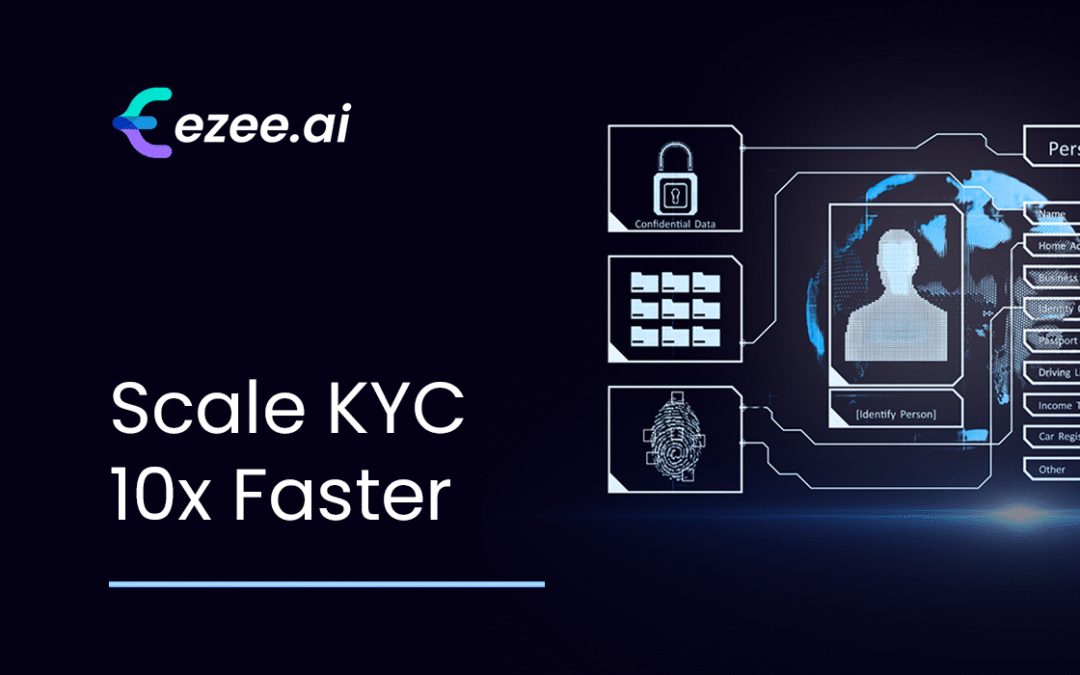
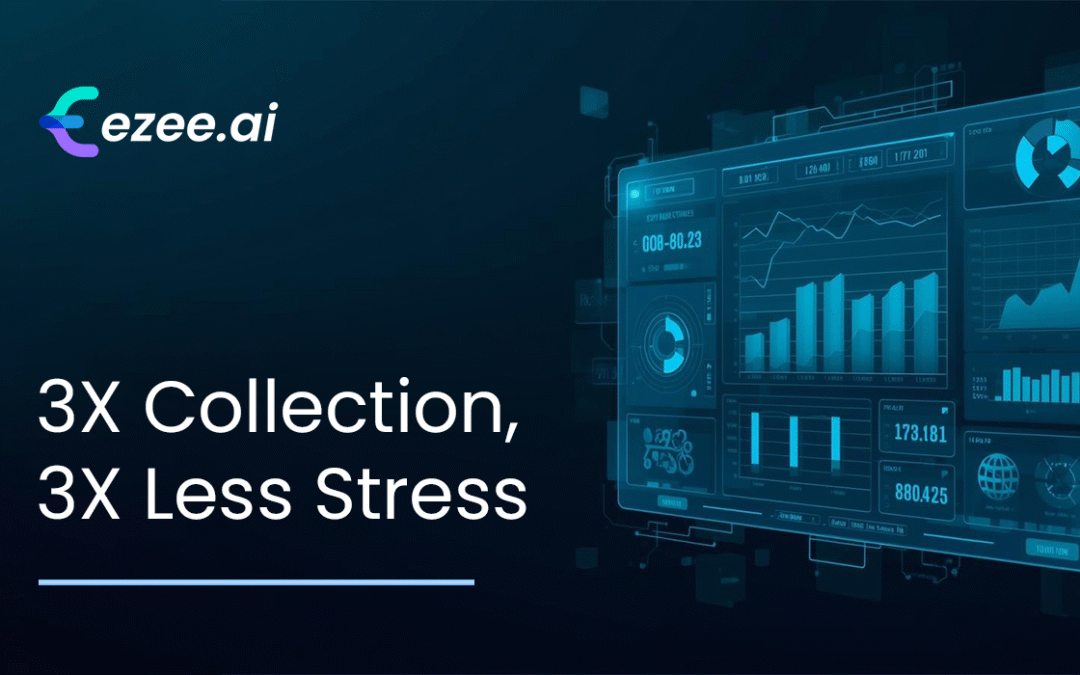

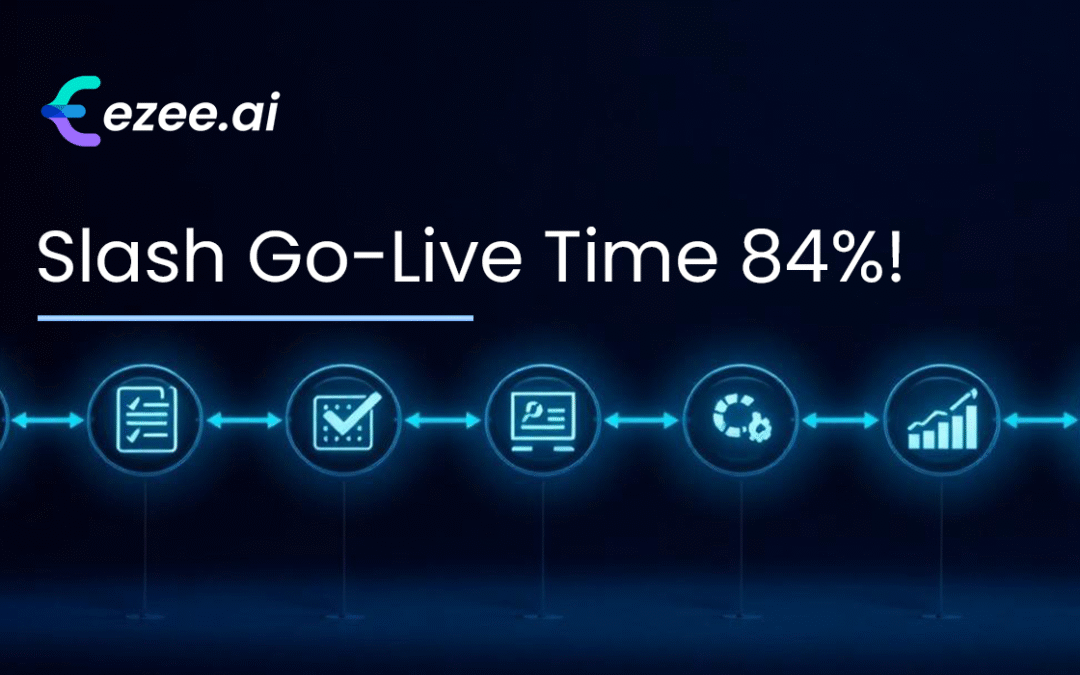



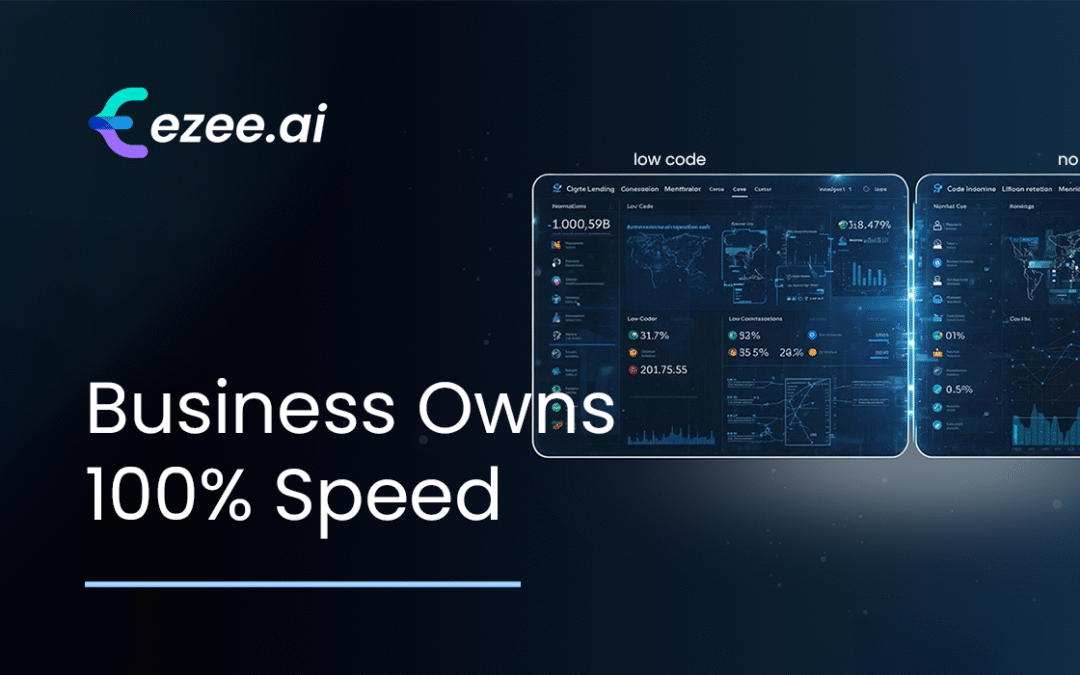


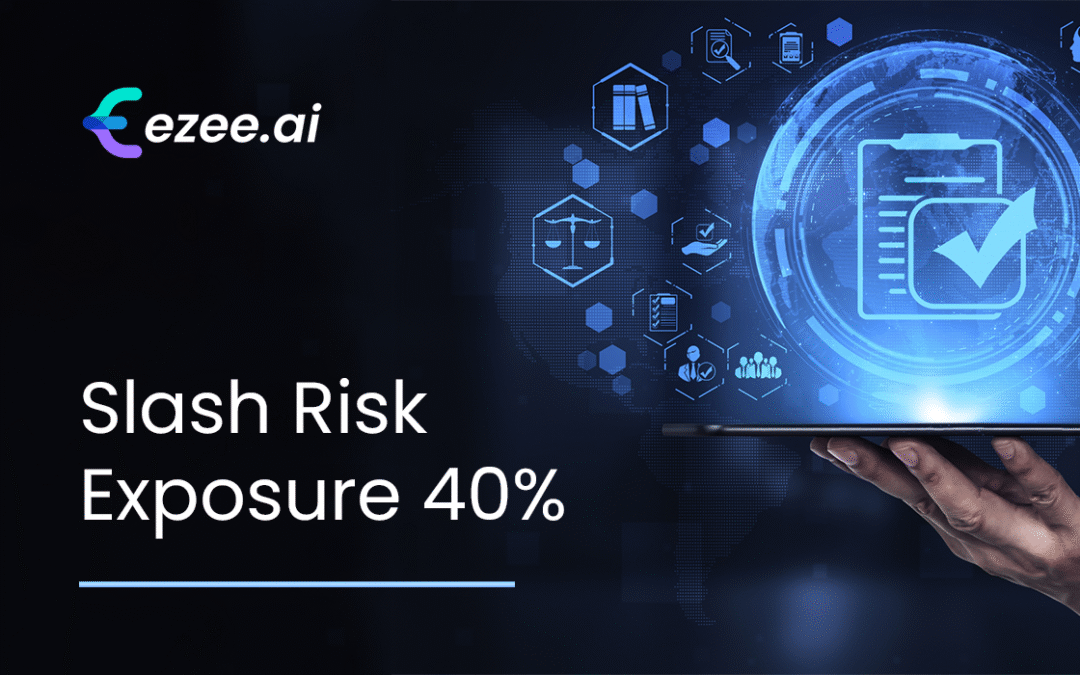

0 Comments